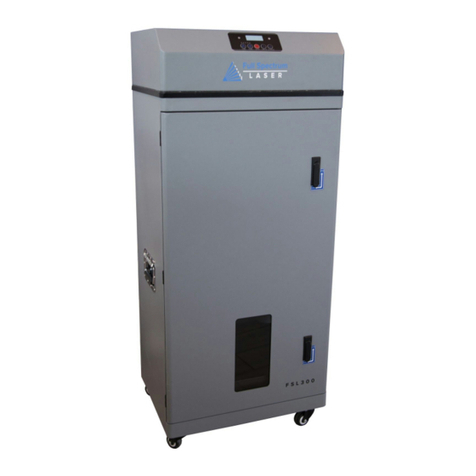
Technical Support is available 8am-5pm PST. Monday - Friday
support@fslaser.com • 702-802-3103
6
CAUTION
Section 1. Safety
Fire Safety
Fire Safety
Laser cutting and engraving systems can present a signicant re hazard due to the extremely high
temperatures generated by the laser beam. While the objective of most cutting and engraving operations
is to vaporize material without burning, most materials capable of being cut or engraved are inherently
combustible and can ignite. Usually this is a small ame of burning material issuing from the cut zone which
self-extinguishes due to the air assist or depowering of the beam. However, it is possible for the ame to
propagate and set re to the machine and its surroundings.
• Always keep a properly maintained and inspected 5lbs. or larger re
extinguisher on hand. Full Spectrum Laser recommends a Halogen re extinguisher or
a multipurpose dry chemical re extinguisher. Halogen extinguishers are more expensive
than a dry chemical, but offer certain advantages should you ever need to use an
extinguisher. The Halogen extinguisher discharges a clean, easily removable substance
that is not harmful to the mechanics or wiring of the laser system. The dry chemical
extinguisher discharges a sticky, corrosive powder that is very difcult to clean up.
• Stacking materials (especially organic materials such as paper) can lead to
increased risk of ame propagation or work piece ignition.
• Never operate your machine unattended. There is a signicant risk of re if the
machine is set improperly, or if the machine should experience a mechanical or
electrical failure while operating.
• Always use the air assist, especially while vector cutting. Vector cutting
movements are relatively slow and apply an extremely large amount of heat to the
workplace. This buildup of heat can create a signicant re risk.
• Never run laser with lid open. Always be sure the lid is closed and never tamper with
lid safety mechanism.
• Always keep the area around the machine clean and free of clutter, combustible
materials, explosives, or volatile solvents such as acetone, alcohol, or gasoline.
• Always use air assist when vector cutting.
• Be cautious when vector cutting. Many materials have the potential to burst suddenly
into ames – even materials that may be very familiar to the user. Always monitor the
machine when it is operating
• Vector cutting with the laser has the most potential to create an open ame.
Acrylic in all its different forms has been shown to be especially ammable when vector
cutting with a laser.
• Never cut pvc (polyvinyl chloride) under any circumstances: fumes are highly
toxic and potentially lethal.
• Never store any ammable materials in the inside of the device or in the
immediate vicinity of the device. Debris and left over produced materials within the
machine must be removed to prevent re hazard.






























